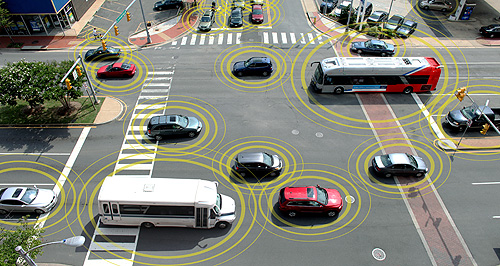Make / Model Search
News - General News - SafetyUS, Germany launch V2X safety trialsEarly warning: Dubbed a social network for cars by some, vehicle-to-vehicle technology can help predict and avoid collisions, reduce congestion and help drivers find a parking spot. Large-scale trials to assess effectiveness of vehicle-to-vehicle communications tech27 Aug 2012 CARS that communicate with other vehicles and the road infrastructure around them to improve safety and reduce congestion are getting closer to production reality with large-scale trials operating on both sides of the Atlantic. Pilot programs in the United States and Germany are now underway, deploying 3000 and 120 vehicles respectively and road infrastructure equipped with vehicle-to-vehicle (V2V) and vehicle-to-infrastructure (V2I) communications technology – commonly referred to as V2X. The 30-month US trial is being conducted in the Ann Arbor area of Michigan by the University of Michigan Transportation Research Institute (UMTRI) with the backing of the Department of Transportation. Car manufacturers supplying vehicles to the $US22 million ($A21.1m) trial include Ford, General Motors, Honda, Hyundai, Kia, Mercedes-Benz, Nissan, Toyota and Volkswagen. The National Highway Transportation Safety Administration (NHTSA) will measure the technology’s effectiveness after the first year, which could result in policy changes that encourage its widespread use before the end of this decade if the trial – which also incorporates trucks and buses – proves successful. UMTRI director Peter Sweatman said V2X technology can “address as much as 80 per cent of crashes of unimpaired drivers and greatly reduce carbon emissions”. The government-sponsored German project ‘Safe Intelligent Mobility – test field Germany’ (simTD), using vehicles supplied by Audi, BMW, Daimler, Ford, Opel and VW, is taking place in the Rhine-Main region that surrounds Frankfurt. The head of cooperating systems at Daimler Research and Advanced Development, Christian Weiss, who is also the simTD project leader, said he is convinced V2X will “play an important role in the mobility of the future”. He said such communication “allows us to detect objects and hazardous situations far beyond the immediate environment of the vehicle (and) this is a significant step on the path towards accident-free driving”. V2X systems incorporate wireless transponders using Wi-Fi, backed up by mobile communications networks, enabling vehicles to exchange information on their position, speed and predicted direction of travel. One example of the system in action is the early warning of vehicles braking heavily ahead up the road, when a view of their brake lights is obscured by larger vehicles in front. Ford Active Safety Research and Innovation technical leader Mike Shulman said that, although the concept of vehicles talking to one another sounds like science fiction, it should not be seen that way. “Mostly, the cars will be sending messages to each other and people won’t even know about it except on the rare occasions when they need a warning or help understanding what’s going on around their vehicle,” said Mr Shulman. Infrastructure such as traffic lights, variable speed limit road signs, traffic congestion monitoring and weather stations can also enter the mix to help build a more accurate prediction of driving conditions such as traffic jams hidden by the crest of a hill or thick fog. The system enables vehicles to predict and avoid potential threats or collisions by notifying the driver or even automatically activating existing active safety systems like autonomous braking, blind-spot monitoring, lane-keeping assistance and adaptive cruise control. When integrated with satellite-navigation systems, V2X technology can help reduce congestion by automatically re-routing vehicles to spread the traffic across more roads. It can also be used to help find vacant parking spaces. GM’s research and development technical fellow for Perception and Vehicle Control Systems, Hariharan Krishnan, said the US trial will help GM determine a timeline for introducing V2X technology on its vehicles around the world. “It will take approximately another five years of market penetration for customers to truly benefit from the technology,” he said. “Ultimately, V2V and V2I technologies stand to improve traffic safety and efficiency for many drivers.” Earlier this month, GM announced it was working on an expansion of the system that uses ‘Wi-Fi Direct’ technology on newer smartphones to enable vehicles to detect and avoid collisions with pedestrians and cyclists who are carrying enabled devices.  Read more7th of August 2012  New technology hits the roadFuture ‘car-to-X’ communications technologies go on trial in Europe1st of August 2012  GM could save lives with smartphonesNew phone technology could save pedestrian and cyclist lives, says General Motors |
Click to shareGeneral News articlesResearch General News Motor industry news |











Facebook Twitter Instagram